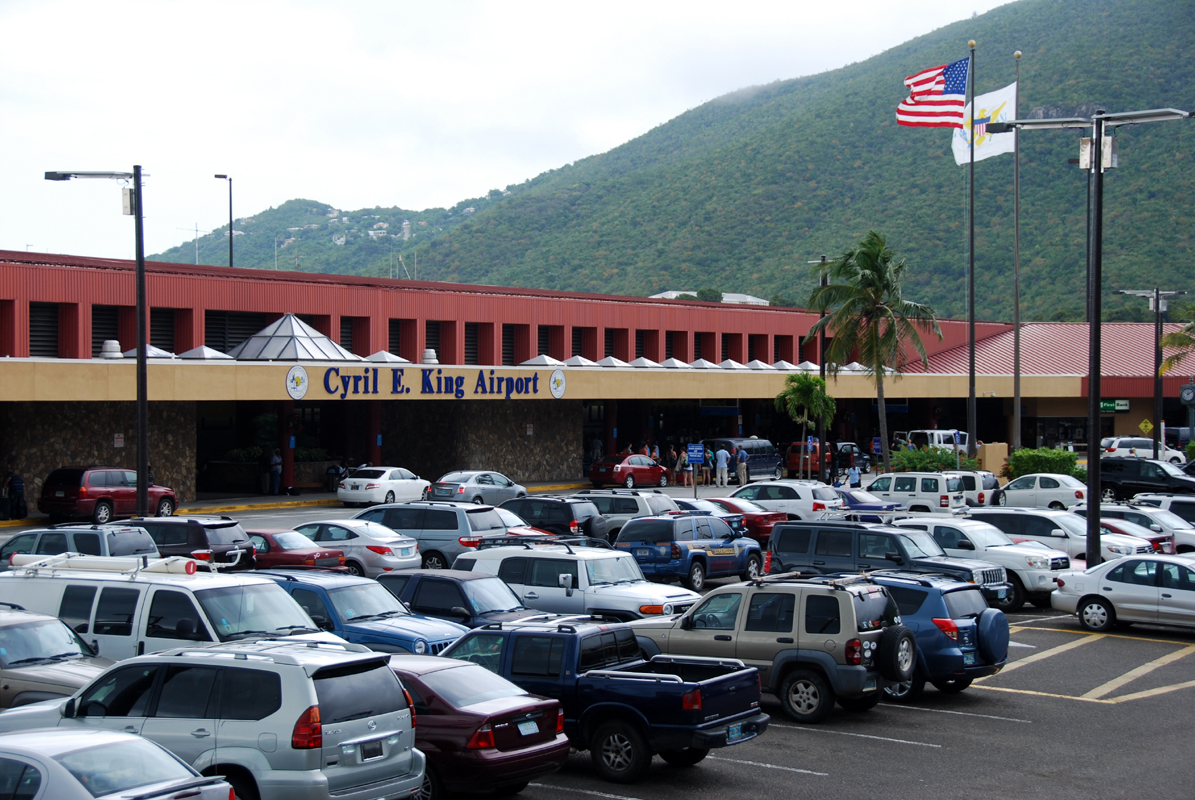First of two articles on the crucial importance of developing the West End Ferry Dock and opening up the West End of Tortola to a tourism oriented commerce: part of an ongoing series of stories on air and seaport development in the British Virgin Islands
The owners of Last Resort, a romantic restaurant nestled luxuriantly on Bellamy Cay at Trellis Bay in the British Virgin Islands, are skeptical of Government’s ‘’good intentions’’ as regards the proposed and now imminent runway extension for Beef Island’s Terrance B Lettsome International Airport. Admittedly, developing and extending the airline facility at Beef Island may have some impact on the pristine environment and surroundings of the quintessentially tropical establishment.
However, the BVI Government has expressed its determination of mitigating, in as much as that is possible, against any negative impact on the environment resulting from this ‘much needed’ and soon to be improved airport facility with runway, for large and powerful jetliners.
Now, whether the fears of the resort owners are justified or not, only time will tell. Still, this ‘Plane Watcher’ holds to his ‘strong conviction’ that an international airport with a hub type dynamic is critical to the future of these Treasure Islands. In any case, the issue of British Virgin Islands airlift, and air and sea port development and expansion: a crucial rendition of plugging the country directly into the nucleus of the global air travel choreography, is not simply a matter of tourism and commerce.
It is more; it is also an issue of national security and even national pride. And if this were an independent country, the challenge of limited and unsatisfactory airlift would have become a matter, even cause, of controlling the national airspace, and the integrity of national sovereignty.
Back to Bellamy Cay, Trellis Bay, and one doesn’t wish to sound too facetious in saying, that to the contrary, the sight and sound of a large jetliner, landing or taking off nearby, and in proximity to well traveled diners, once or twice a day, may actually be a boon to the tranquility of the place, giving customers a greater appreciation for paradise during the long quiet periods before the next international arrival and departure.
A new experience for the establishment’s guests, yes: and yours truly is definitely excited about gracing this famous and Last Resort in the coming days for an exotic bite. Then, when the time comes in the near future for flight 100 arriving Heathrow London, what a great place Last Resort would be, to sip at a colada, watching intently as the beautiful beast of steel and aluminum descends from a setting sun: he hopes he isn’t thrown out though! OK, enough for humour and laughter; that it is the best medicine, and so on and so forth!
Yes, enough said! And for the purposes of this particular twin narrative, on the critical importance of St. Thomas as an international transit point, serving the British Virgin Islands, an excellent article written by the Last Resort owners, of March 22, 2012, in the BVI Beacon Newspaper headed ‘’ Last Resort owners question airport plan,’’ was paradoxically a hue and cry that gave this reader good reason for thought on another matter.
Interestingly, the article in the Beacon, although a protest against the imminent runway expansion on Beef Island, was actually much more. It was an exhortation to these eclectic Virgin Islands not to overlook the potential of developing a much improved dynamic on the opposite and Western End of Tortola.
The West End of the island is a natural receptacle for visitors from the United States, and a much used port of entry and exit for locals and aliens alike.
The Last Resort owners correctly asserted in their opinion piece that the BVI ‘’ change the perception of St. Thomas from one of being competition to that of being a great resource.’’ The owners admonished that what ‘’ the VI needs to do is ensure a fast, comprehensive, and convenient ferry and air service to meet the passengers who are travelling on to the BVI.’’ That ‘’it is ridiculous the last ferry leaves Charlotte Amalie as early as 4.15pm, thus precluding an onward connection for any passenger who lands in St. Thomas after 3.30pm. It also makes little sense that several ferries all leave more or less at the same time.’’
The owners further described how guests ‘’ generally find the 45 minute trip a pleasant cruise through the islands, certainly better than a two hour layover in some US hub airport.’’ The resort owners insisted that the BVI must ‘’ let the United States Virgin Islands have all the dirty, noisy, cut price, direct flights landing on its enviably long runway, and let them also deal with up to 300 stranded passengers when flights get cancelled.’’ However, even this does not preclude the BVI from constructing an ‘’enviably long runway’’ of its own, one might add.
OK, this Observer of life’s quirks, foibles and peculiarities, was on a ferry leaving West End, on the Island of Tortola in the British Virgin Islands, one bright morning, sometime in late March 2012, with a very well known Native Virgin Islander and friend. The ‘wise head,’ for most of the ferry trip, clearly explained to this enthusiastic listener why he believed developing the port facility at Sopers Hole was critical to the economy of the country.
But even before his rendition, while gazing at the shrinking, but sunny and enchanting, luscious shoreline, as the ferry departed, there was little doubt there was great scope for building a mega ferry port and luxury yacht facility at Sopers Hole: a transforming of a clearly inadequate facility there, into a modern, attractive, and state of the art harbour and wharf.
A ‘spanking’ new infrastructure, even port architecture, that would be good for the West End and its inhabitants, with the potential for handling much more efficiently and comfortably, tens of thousands of travelers and boaters arriving from the United States Virgin Islands, and even cruise ship passengers from ships anchored in the channels, between St. John, Tortola, Great Thatch, and Jost Van Dyke.
The ‘Great Virgin Islander’ described how, with a greatly improved facility, cruise ships and passengers could then be diverted from Road Town to the West End, and shuttled over pristine waters into the new dock, to meet with a friendly and proficient tour guide for that crucial guided trip around the Island. Not to mention many more visitors accessing the West of Tortola, and ambling into inns, restaurants, bars, and shops. This would benefit small business owners at Sopers Hole, Capoons Bay, Carrot Bay, and Cane Garden Bay. A new and creatively designed port facility could also help to decongest Road Town by opening up the West End of Tortola commercially.
A facility of the type, according to the ‘Source,’ could be built with minimum interference, in terms of the enjoyment of boaters and yacht charter guests at the marinas sprinkled around Sopers Hole. This was evident from the fact that most construction would take place on the opposite side of the small channel, and natural marina and yacht harbour, away from where Pussers is located in Sopers Hole, and away from most of the boating activity. The Jolly Roger could be inconvenienced by port construction for a time, however.
Then after construction, the new facility, if intelligently designed, should actually boost the area environmentally, increase the number of berths and anchorages, enhance the attractiveness of the tiny channel that is Soper’s Hole; not spoil a picturesque idyll as some have suggested; and further improve access into the BVI by the commercially all important overnight guest and visitor.
OK, no one resident on these paradise islands has ever doubted that the West End Ferry Dock facility is critical to the economic wellbeing of these British Virgin Islands, especially with regard to tourism. Furthermore, the Sopers Hole marina and ferry facility affects the standard and quality of life of most Virgin Islanders and residents.
Precise figures on the number of British Virgin Islands visitors and tourists
using the Cyril E King International Airport facility in neighbouring St. Thomas, in the United States Virgin Islands, before arriving at their final destination in the British Virgin Islands are unclear.
But as most Virgin Islanders and residents fully appreciate, this number is probably very substantial indeed. Add airlift limitations caused by financial difficulties faced by regular air carriers into the Terrance B Lettsome International Airport on Beef Island, such as American Airlines and even LIAT, and the importance of West End as a BVI port of entry increases substantially.
BVI Beacon Contributor William Walker, attempting this feat, and writing in the February 23, 2012 Edition of the BVI Beacon Newspaper, a story titled ‘’ Runway extension considered in light of tourist numbers,’’ was, as is his norm, very thorough in giving figures obtained from the BVI Government’s Development Planning Unit’s Statistics Section.
In 2011 for example, according to Walker, West End Dock received 33.3% passenger arrivals from St. Thomas; Road Town 20.8%; while Beef Island saw 29.8% airline passenger arrivals. A figure of 15% for Virgin Gorda and 1% for Anegada was also proffered. The Writer described how Jost Van Dyke also acts as a port of entry, but most tourists to that sister island ‘’ seem to be from St. Thomas via St. John, or as yachting entry visitors, presumably also mostly from St. Thomas.’’
Walker gave figures for overnight guests arriving in the territory in 2011 as 290, 600 arrivals. ‘’ 64.1% arrived by ferry at either West End or Road Town, the remainder 29.8% arrived at Beef Island. 15% probably arrived on yachts at either Virgin Gorda or Jost Van Dyke
These figures give the country a glimpse at the importance of the USVI as a transit point and main artery into the British Virgin Islands.
To be continued





